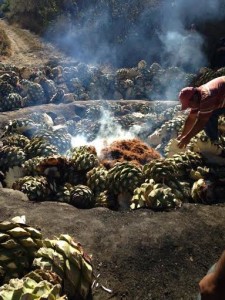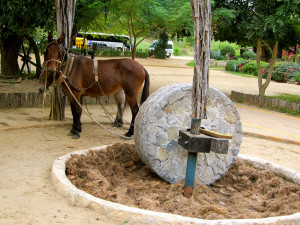 Last January, the general manager of McKinney and Doyle, and a very close personal friend of mine, Andrew Sarubbi traveled to Oaxaca, Mexico to learn how to make Mezcal. Mezcal is a distilled alcoholic beverage, smoky in flavor, made from the agave plant. Recently, the food, specifically the bar, industry has seen a surge in new agave distillates entering the market. It can be tricky to understand the subtle nuances among them so I thought that with Cinco de Mayo right around the corner, today would be a great day to talk a little about them, specifically between tequila and mezcal. A lot of people describe mezcal as a type of tequila, but it’s actually the other way around. Mezcal is a much broader category that encompasses tequila. Let’s dive a little deeper, shall we?
Last January, the general manager of McKinney and Doyle, and a very close personal friend of mine, Andrew Sarubbi traveled to Oaxaca, Mexico to learn how to make Mezcal. Mezcal is a distilled alcoholic beverage, smoky in flavor, made from the agave plant. Recently, the food, specifically the bar, industry has seen a surge in new agave distillates entering the market. It can be tricky to understand the subtle nuances among them so I thought that with Cinco de Mayo right around the corner, today would be a great day to talk a little about them, specifically between tequila and mezcal. A lot of people describe mezcal as a type of tequila, but it’s actually the other way around. Mezcal is a much broader category that encompasses tequila. Let’s dive a little deeper, shall we?
Yes, mezcal and tequila are both made from the harvested agave plant. The harvest phase can take anywhere from eight to 10 years depending on the varietal of the liquor. The process is where the real differences come into play.
The first step is the same for both distillates. To start, you ax chop the piña, which is the heart of the agave plant, in half or quarters depending on the size. The piña grows underground but as the plant matures over time, the top of it starts to poke through the soil a little bit. Once this is complete, the process changes depending on the intended product.
When making tequila, the piña is roasted in a horno (basically an above ground oven) whereas mezcal is roasted in a pit dug into the ground. Producers use the wood from local trees as well as bagasso – the remnants of the chopped and shredded piña – to start the fire in the pit. It’s important to note that different wood is used to produce different mezcals. The devil is in the details people. Anyway, the piña is roasted for any number of days to provide low to high levels of that amazing smoky flavor.
Now the two processes become similar again. After roasting, the piña is crushed with a tahona. The best way to describe a tahona is through an image, so take a look at the photo below. The tahona is the big stone wheel.
It’s time to move on to fermentation. After the crushing phase, producers collect the juice and remaining shreds and put everything together into a fermentation tank. There are multiple techniques that could be used here all dependent on the desired outcome and flavor. General fermentation is a post or two all on its own, but regardless of the chosen technique, the objective is the same: fermentation of the juices.
And finally, distillation. Tequila is typically distilled in a column still and mezcal in a pot still. Again, I could go on for pages about distillation in general but for the purposes of this post just know that the column still allows for a cleaner flavor in the tequila.
Do you need to know how something is made to enjoy it? No. But understanding the process and detail that goes into making anything can certainly add to your appreciation of the final product. Andrew told me that during his trip and experience in Oaxaca he discovered a new found and elevated respect for smaller family run distilleries that use tradition and culture throughout the entire production process. He spent time working in the fields and chopping the piñas (which I am told are seriously heavy) and really learning about the different techniques used over generations. There is so much history behind the things that we love. Learning about it only adds to our appreciation, which allows us to enjoy it even more.
Rebecca McKinney
I wanted to create this blog for a few reasons. First and foremost, to share tips, tricks, and knowledge about the food and beverage industry in general but also to help people see a different side of the restaurant world. Every restaurant has a totally unique culture and world within it. I want to help open people’s eyes to more than how fast the service is or how easy or hard it is to secure a reservation.
So, thanks for stopping by! I welcome your ideas, input, and feedback and hope you enjoy!
Eat well & travel often,
Becky McKinney
Latest posts by Rebecca McKinney (see all)
- Why Food Makes the Best Gift for a New Mom - April 12, 2023
- 5 Ingredients to Cook With This Spring - March 15, 2023
- 10 Reasons to Dine Out on Valentine’s Day - February 2, 2023




Leave a Reply